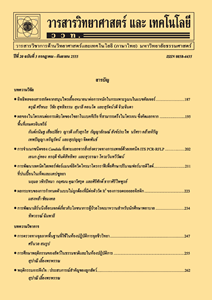พีเอชที่เหมาะสมต่อการผลิตเอนไซม์เบต้ากลูโคซิเดสโดยรีคอมบิแนนท์ Pichia pastoris ด้วยกระบวนการหมักแบบเฟด-แบทช์
Main Article Content
Abstract
บทคัดย่อ
เบต้ากลูโคซิเดส (EC 3.2.1.21) เป็นหนึ่งในสามเอนไซม์ในกลุ่มเซลลูเลสที่ทำหน้าที่ในการเร่งการย่อยสลายอัลคิล- และอาริล-เบต้ากลูโคไซด์ ไดกลูโคไซด์ และโอลิโกกลูโคไซด์ ซึ่งมีความสำคัญสำหรับการผลิตน้ำตาล เครื่องดื่ม รวมถึงอาหารสัตว์ ซึ่งการศึกษาการผลิตเบต้ากลูโคซิเดสในงานวิจัยนี้ดำเนินการโดยใช้รีคอมบิแนนท์ Pichia pastoris ที่มียีนเบต้ากลูโคซิ-เดสจากรา Periconia sp. BCC2871 ด้วยกระบวนการหมักแบบเฟด-แบทช์ โดยอิทธิพลของพีเอชต่อการผลิตเบต้ากลูโค-ซิเดสทำการศึกษาโดยแปรผันค่าพีเอช (5.0, 5.5, 6.0 และ 6.5) ภายใต้สภาวะควบคุมอื่น ๆ ที่เหมือนกัน (อัตราการกวน 1000 รอบต่อนาที อัตราการให้อากาศ 1 ลิตรต่อลิตร.นาที อุณหภูมิ 30 องศาเซลเซียส) และควบคุมอัตราการเติมเมทานอลในระยะผลิตที่ 1.07 กรัมต่อลิตร.ชั่วโมง (3.99 กรัมต่อชั่วโมง) ผลการทดลองแสดงให้เห็นว่าในทุกการทดลอง กิจกรรมของเบต้ากลูโคซิเดสมีค่าสูงขึ้นอย่างต่อเนื่องในระดับการเพิ่มขึ้นของกิจกรรมที่มีความแตกต่างกันอย่างมีนัยสำคัญในแต่ละพีเอชที่ทำการศึกษา และเมื่อสิ้นสุดกระบวนการที่ 120 ชั่วโมง ของระยะการผลิต ค่ากิจกรรมของเบต้ากลูโคซิเดสสูงที่สุดได้จากการดำเนินการผลิตที่ พีเอช 6.0 โดยให้ค่ากิจกรรมของเบต้ากลูโคซิเดสเท่ากับ 776.67±32.99 หน่วยต่อมิลลิลิตร ซึ่งมีค่าสูงกว่าค่าที่ได้จากการดำเนินการผลิตที่พีเอช 5.0, 5.5 และ 6.5 ประมาณ 2.4, 1.4 และ 1.3 เท่า ตามลำดับ ดังนั้นพีเอชที่เหมาะสมในการผลิตเบต้ากลูโคซิเดสจากรา Periconia sp. BCC2871 โดยรีคอมบิแนนท์ P. pastoris ด้วยกระบวนการเพาะเลี้ยงแบบเฟด-แบทช์ คือ พีเอช 6.0
คำสำคัญ : เบต้ากลูโคซิเดส; Pichia pastoris; การหาพีเอชที่เหมาะสม; การเพาะเลี้ยงแบบเฟด-แบทช์
Abstract
b-glucosidase (EC 3.2.1.21), one of the three main members of cellulolytic enzymes, catalyzes the hydrolysis of alkyl- and aryl-b-glucosides, diglucosides, and oligoglucosides that are important for sugar, brewery as well as animal feed production. The study on b-glucosidase production was carried out using recombinant yeast Pichia pastoris expressing b-glucosidase from the fungal Periconia sp. BCC2871 with the fed-batch fermentation. The effect of pH on b-glucosidase production was examined at various pH (5.0, 5.5, 6.0, and 6.5) under the same cultivation conditions (agitation 1000 rpm, aeration 1 vvm, and temperature 30 °C). The methanol feed rate during production stage was controlled at 1.07 g L-1h-1 (3.99 g h-1). The results indicated that b-glucosidase activity continuously increased with significantly different values. At the end of the process (120 h of production time), the highest b-glucosidase activity was obtained at pH 6.0 (776.67±32.99 U mL-1) which was higher than that of pH 5.0, 5.5, and 6.5 about 2.4, 1.4, and 1.3 times, respectively. The optimum pH for Periconia sp. BCC2871 b-glucosidase production using recombinant yeast P. pastoris was therefore pH 6.0.
Keywords: b-glucosidase; Pichia pastoris; pH optimization; fed-batch fermentation


